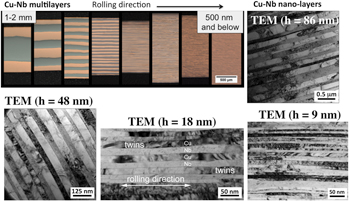Crossref Citations
This article has been cited by the following publications. This list is generated based on data provided by
Crossref.
Han, Weizhong
Demkowicz, Michael J.
Mara, Nathan A.
Fu, Engang
Sinha, Subhasis
Rollett, Anthony D.
Wang, Yongqiang
Carpenter, John S.
Beyerlein, Irene J.
and
Misra, Amit
2013.
Design of Radiation Tolerant Materials Via Interface Engineering.
Advanced Materials,
Vol. 25,
Issue. 48,
p.
6975.
Mayeur, J.R.
Beyerlein, I.J.
Bronkhorst, C.A.
Mourad, H.M.
and
Hansen, B.L.
2013.
A crystal plasticity study of heterophase interface character stability of Cu/Nb bicrystals.
International Journal of Plasticity,
Vol. 48,
Issue. ,
p.
72.
Beyerlein, Irene J.
Wang, Jian
and
Zhang, Ruifeng
2013.
Mapping dislocation nucleation behavior from bimetal interfaces.
Acta Materialia,
Vol. 61,
Issue. 19,
p.
7488.
Monclús, M. A.
Zheng, S. J.
Mayeur, J. R.
Beyerlein, I. J.
Mara, N. A.
Polcar, T.
Llorca, J.
and
Molina-Aldareguía, J. M.
2013.
Optimum high temperature strength of two-dimensional nanocomposites.
APL Materials,
Vol. 1,
Issue. 5,
Ekiz, E.H.
Lach, T.G.
Averback, R.S.
Mara, N.A.
Beyerlein, I.J.
Pouryazdan, M.
Hahn, H.
and
Bellon, P.
2014.
Microstructural evolution of nanolayered Cu–Nb composites subjected to high-pressure torsion.
Acta Materialia,
Vol. 72,
Issue. ,
p.
178.
Mara, Nathan A.
and
Beyerlein, Irene J.
2014.
Review: effect of bimetal interface structure on the mechanical behavior of Cu–Nb fcc–bcc nanolayered composites.
Journal of Materials Science,
Vol. 49,
Issue. 19,
p.
6497.
Wang, Miao
Averback, Robert S.
Bellon, Pascal
and
Dillon, Shen
2014.
Chemical mixing and self-organization of Nb precipitates in Cu during severe plastic deformation.
Acta Materialia,
Vol. 62,
Issue. ,
p.
276.
Zheng, S.J.
Wang, J.
Carpenter, J.S.
Mook, W.M.
Dickerson, P.O.
Mara, N.A.
and
Beyerlein, I.J.
2014.
Plastic instability mechanisms in bimetallic nanolayered composites.
Acta Materialia,
Vol. 79,
Issue. ,
p.
282.
Carpenter, John S.
McCabe, Rodney J.
Zheng, Shijian J.
Wynn, Thomas A.
Mara, Nathan A.
and
Beyerlein, Irene J.
2014.
Processing Parameter Influence on Texture and Microstructural Evolution in Cu-Nb Multilayer Composites Fabricated via Accumulative Roll Bonding.
Metallurgical and Materials Transactions A,
Vol. 45,
Issue. 4,
p.
2192.
Sobie, Cameron
McPhie, Mathieu G
Capolungo, Laurent
and
Cherkaoui, Mohammed
2014.
The effect of interfaces on the mechanical behaviour of multilayered metallic laminates.
Modelling and Simulation in Materials Science and Engineering,
Vol. 22,
Issue. 4,
p.
045007.
Zhou, J.
Averback, R.S.
and
Bellon, P.
2014.
Stability and amorphization of Cu–Nb interfaces during severe plastic deformation: Molecular dynamics simulations of simple shear.
Acta Materialia,
Vol. 73,
Issue. ,
p.
116.
Ardeljan, Milan
Beyerlein, Irene J.
and
Knezevic, Marko
2014.
A dislocation density based crystal plasticity finite element model: Application to a two-phase polycrystalline HCP/BCC composites.
Journal of the Mechanics and Physics of Solids,
Vol. 66,
Issue. ,
p.
16.
Han, W.Z.
Cerreta, E.K.
Mara, N.A.
Beyerlein, I.J.
Carpenter, J.S.
Zheng, S.J.
Trujillo, C.P.
Dickerson, P.O.
and
Misra, A.
2014.
Deformation and failure of shocked bulk Cu–Nb nanolaminates.
Acta Materialia,
Vol. 63,
Issue. ,
p.
150.
Zhang, R.F.
Germann, T.C.
Liu, X.-Y.
Wang, J.
and
Beyerlein, I.J.
2014.
Layer size effect on the shock compression behavior of fcc–bcc nanolaminates.
Acta Materialia,
Vol. 79,
Issue. ,
p.
74.
Zheng, Shijian
Carpenter, John S.
Wang, Jian
Mara, Nathan A.
and
Beyerlein, Irene J.
2014.
An interface facet driven Rayleigh instability in high-aspect-ratio bimetallic nanolayered composites.
Applied Physics Letters,
Vol. 105,
Issue. 11,
Beyerlein, I.J.
Mayeur, J.R.
McCabe, R.J.
Zheng, S.J.
Carpenter, J.S.
and
Mara, N.A.
2014.
Influence of slip and twinning on the crystallographic stability of bimetal interfaces in nanocomposites under deformation.
Acta Materialia,
Vol. 72,
Issue. ,
p.
137.
Cobb, Josef
Vachhani, Shraddha
Dickerson, Robert M.
Dickerson, Patricia O.
Han, Weizhong
Mara, Nathan A.
Carpenter, John S.
and
Schneider, Judy
2014.
Layer Stability and Material Properties of Friction-Stir Welded Cu–Nb Nanolamellar Composite Plates.
Materials Research Letters,
Vol. 2,
Issue. 4,
p.
227.
Wang, Jian
Zhou, Caizhi
Beyerlein, Irene J.
and
Shao, Shuai
2014.
Modeling Interface-Dominated Mechanical Behavior of Nanolayered Crystalline Composites.
JOM,
Vol. 66,
Issue. 1,
p.
102.
Nizolek, T.
Mara, N. A.
Beyerlein, I. J.
Avallone, J. T.
Scott, J. E.
and
Pollock, T. M.
2014.
Processing and Deformation Behavior of Bulk Cu–Nb Nanolaminates.
Metallography, Microstructure, and Analysis,
Vol. 3,
Issue. 6,
p.
470.
Knezevic, Marko
Nizolek, Thomas
Ardeljan, Milan
Beyerlein, Irene J.
Mara, Nathan A.
and
Pollock, Tresa M.
2014.
Texture evolution in two-phase Zr/Nb lamellar composites during accumulative roll bonding.
International Journal of Plasticity,
Vol. 57,
Issue. ,
p.
16.



